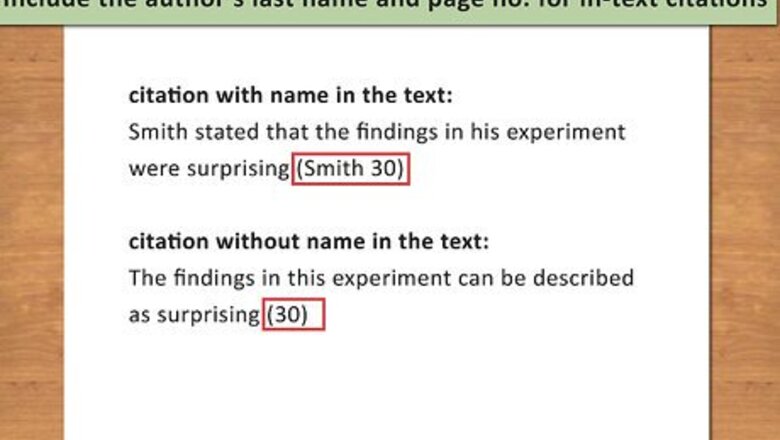
views
Using MLA Style Internal Citations
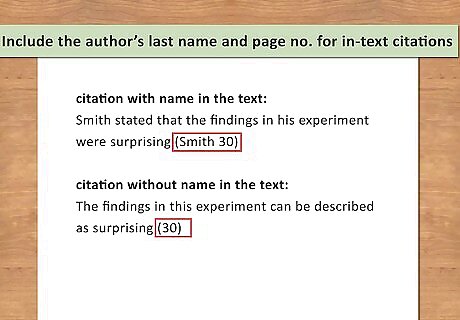
Include the author’s last name for in-text citations. Print sources include magazines, books, newspapers, and scholarly journal articles. When citing these kinds of sources that have a known author, cite the author’s last name and a page number. If you use the author’s last name within the text, you don’t need to repeat it in the citation; just include the page number within the parentheses. Example of a citation with name in the text: “Smith stated that the findings in his experiment were surprising (Smith 30).” Example of a citation without name in the text: “The findings in this experiment can be described as surprising (30).”
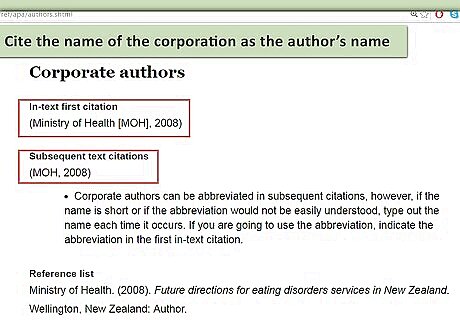
Cite the name of the corporation as the author’s name. Some sources have a corporate author (the individual writer is not specified)—in these instances, simply use the name of the corporation as the author’s name. In cases in which the corporation has a long or complicated name, use its abbreviation to make for more fluid reading.

Cite the article’s title if the source does not have a given author. Follow this with the page number the passage was taken from. This is common for smaller website pages, which often do not list an individual author. (For long titles, instead of using the title in its entirety, use a condensed version.) If the source is a short work—like a journal article, book chapter, or poem—put the title in quotations when citing. If the source is a long work—like a book, play, or even a television show—italicize the title.
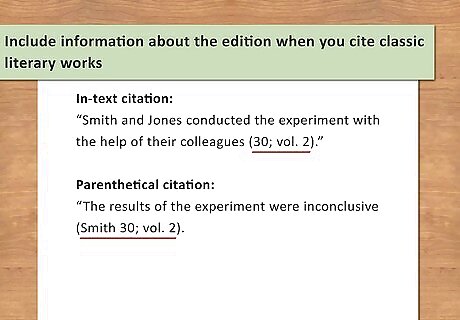
Include information about the edition when you cite classic literary works. Well-known literary works—especially those written before the 20th century—will have multiple published editions. In order to avoid confusion between the different editions, in addition to providing the author and page number in your in-text citation, provide more information about the source such as the volume (vol.), chapter (ch.), book (bk.), part (pt.), or section (sec.) number. Use a semicolon to separate these from the page number. In-text citation: “Smith and Jones conducted the experiment with the help of their colleagues (30; vol. 2).” Parenthetical citation: “The results of the experiment were inconclusive (Smith 30; vol. 2).”
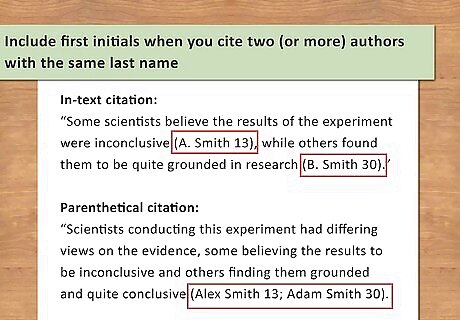
Include first initials when you cite two (or more) authors with the same last name. If you find that two or more authors within a source share the same last name, use their first initials for differentiation. If two or more authors share both the same last name and first initial, use their full names. In-text citation: “Some scientists believe the results of the experiment were inconclusive (A. Smith 13), while others found them to be quite grounded in research (B. Smith 30).” Parenthetical citation: “Scientists conducting this experiment had differing views on the evidence, some believing the results to be inconclusive and others finding them grounded and quite conclusive (Alex Smith 13; Adam Smith 30).”

Cite sources with three or more authors. If citing a source with three authors or more, include the author’s last names plus the page number the passage was found on. In-text citation: “Smith, Jones, and White suggest that the results to the experiment were inconclusive (30).” Parenthetical citation: “The authors state, ‘Significant evidence suggests that the results to the experiment were inconclusive (Smith, Jones, and White 30).’ ”
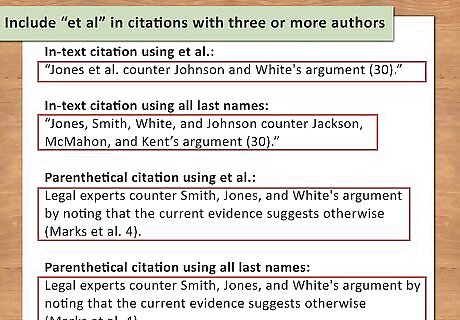
Include “et al” in citations with three or more authors. If your source contains more than three authors, you have two options for proper referencing. You may use just the first author’s last name, followed by “et al.” (This is a common Latin phrase which means “and others”), or you may use all of the authors’ last names in your citation. In cited works with a longer list of authors, consider using the “et al.” option. In-text citation using et al.: “Jones et al. counter Johnson and White's argument (30).” In-text citation using all last names: “Jones, Smith, White, and Johnson counter Jackson, McMahon, and Kent’s argument (30).” Parenthetical citation using et al.: Legal experts counter Smith, Jones, and White's argument by noting that the current evidence suggests otherwise (Marks et al. 4). Parenthetical citation using all last names: Legal experts counter Smith, Jones, and White's argument by noting that the current evidence suggests otherwise (Marks et al. 4).

Cite multiple works with the same author. When referencing several sources with the same author, cite the work using a condensed version of the title followed by the page number. When citing articles and other shorter works, use quotation marks. When citing books and other longer works, italicize the title.
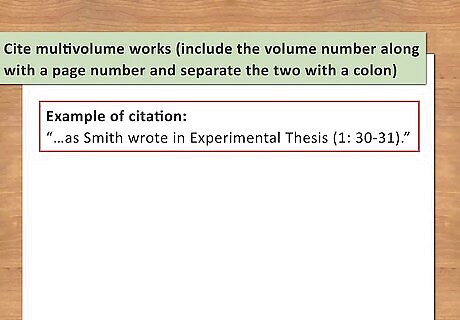
Cite multivolume works. Some sources have multiple volumes. When referencing different volumes of one particular source, be sure to include the volume number along with a page number and separate the two with a colon. When citing just one volume within a multivolume source, just the page number should be provided in parentheses. Example of citation: “…as Smith wrote in Experimental Thesis (1: 30-31).”
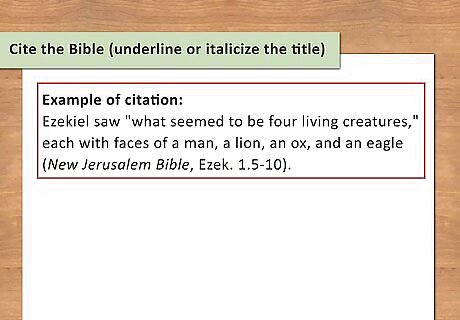
Cite the Bible. There are many common translations of the Bible, including the King James Version, English Standard Version, and New International Version. As such, you want to distinctly identity which Bible translation you are referencing and then be sure to name the book, chapter, and verse within your citation. When stating the version of the Bible, italicize or underline the title. When stating the specific book from the Bible you are referencing, do not italicize or underline its title. Example of citation: Ezekiel saw “what seemed to be four living creatures,” each with faces of a man, a lion, an ox, and an eagle (King James Holy Bible, Ezek. 1.5-10).
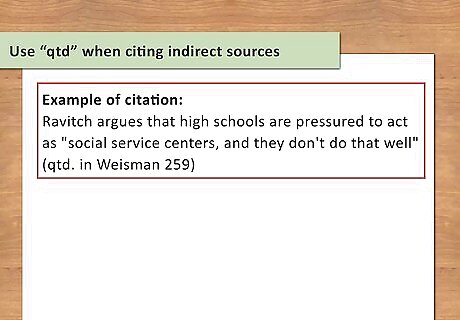
Use “qtd” when citing indirect sources. Indirect sources are secondary sources that are already referenced within a source. When citing this type of source write “qtd.” before the name of the source, followed by the page number. For example: “… (qtd. in Smith 230)…”
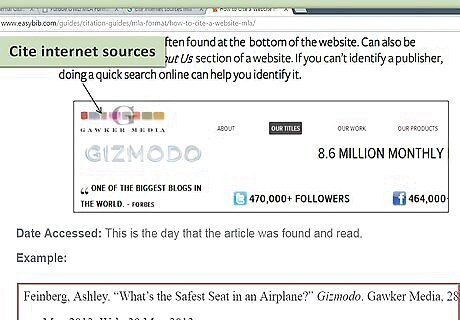
Cite internet sources. For sources found electronically, page and paragraph numbers may not exist; you do not need to include them within your citation. Simply cite the name of the article, film, or website when citing an internet source.
Using APA Style Internal Citations
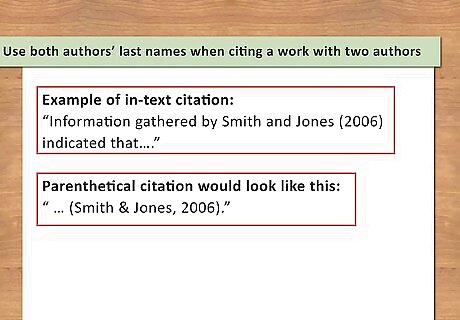
Use both authors’ last names when citing a work with two authors. When referencing a source with two authors, be sure to use both last names within one single phrase. When citing within the text, the names are joined with the word “and,” followed by the date of publication in parentheses. For parenthetical citation, use an ampersand, followed by a comma and the year of publication, all within parentheses. As in MLA, the parenthetical citation should appear after the sentence has ended, but prior to the period. For example, “(Smith & Jones, 2001).” Name both authors every time you cite this source. An example in-text citation would look like this: “Information gathered by Smith and Jones (2006) indicated that….” Parenthetical citation would look like this: “ … (Smith & Jones, 2006).”
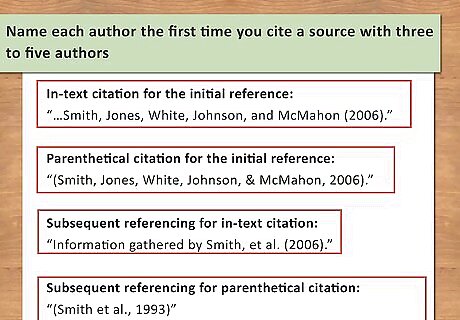
Name each author the first time you cite a source with three to five authors. APA style requires you to name each author within a single phrase only the first time you cite this source. Join the authors’ names with an “and” within the text and with an ampersand for parenthetical citation. For successive citations, just use the first author’s last name and “et al.” In-text citation for the initial reference: “…Smith, Jones, White, Johnson, and McMahon (2006).” Parenthetical citation for the initial reference: “(Smith, Jones, White, Johnson, & McMahon, 2006).” Subsequent referencing for in-text citation: “Information gathered by Smith, et al. (2006).” Subsequent referencing for parenthetical citation: “(Smith et al., 1993)”
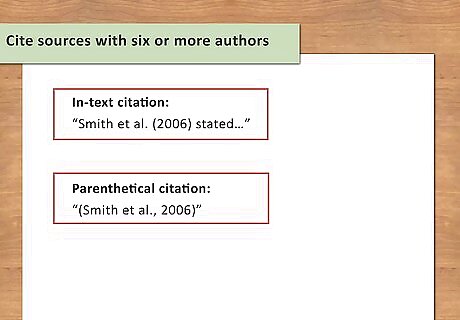
Cite sources with six or more authors. When referencing sources with six authors or more, use the first author’s last name only for both parenthetical and in-text citations, followed by “et al.” In-text citation: “Smith et al. (2006) stated…” Parenthetical citation: “(Smith et al., 2006)”
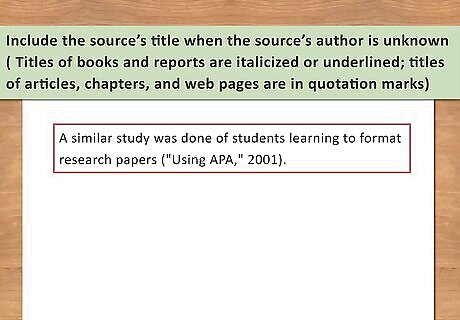
Include the source’s title when the source’s author is unknown. Sometimes a source has no author or the author cannot be found. When this is the case, use the source’s title; if the title is lengthy, you can shorten it and include only the first word or two within the parentheses. Cite sources with unknown author. As with MLA style, use the article’s title (or a shortened version of the title) in place of an author’s name: “The experiment yielded multiple results (“Learning Theory,” 2006).” Titles of web pages, articles, and chapters are cited using quotation marks. Titles of reports and books are italicized.
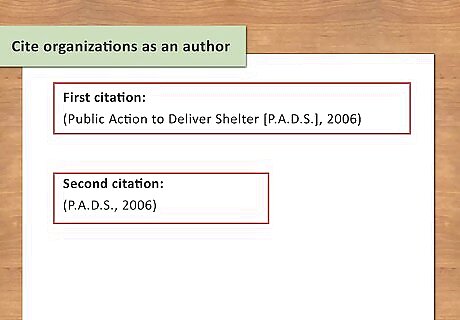
Cite organizations as an author. As in MLA style, if your source is a government agency or an organization, use the entire name during your initial citation. If the name has an abbreviation, indicate it within brackets the first time citing this source. For subsequent citations, only use the abbreviation. First citation: (Public Action to Deliver Shelter [P.A.D.S.], 2006) Second citation: (P.A.D.S., 2006)
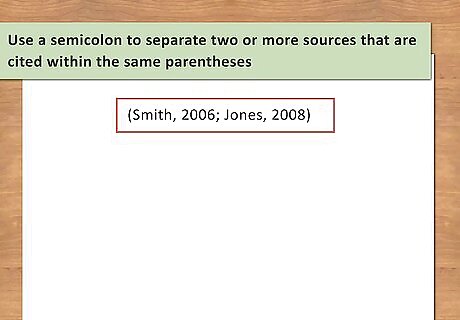
Use a semicolon to separate two or more sources that are cited within the same parentheses. There are times when you may need to reference two or more sources within one parenthetical in-text citation. When doing this, separate the two sources using a semicolon, then the sources in alphabetical order by author’s last name. Your citation would look like this, (Smith, 2006; Jones, 2008).

Include authors’ first initials to avoid confusion between two cited authors with the same last name. At times you may run into two authors with the same name. When this occurs, simply avoid any uncertainties by using first initials along with the last names of both cited authors. Your citation would like this, (A. Smith, 2005; B. Jones, 2008).
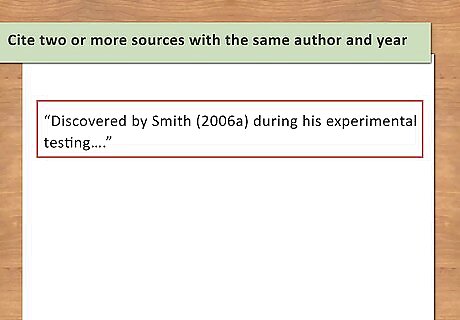
Cite two or more sources with the same author and year. When using two or more sources published in the same year and authored by the same person, simply use lower case letters, alphabetically, after the year of publication to distinguish them. For example: “Discovered by Smith (2006a) during his experimental testing….”
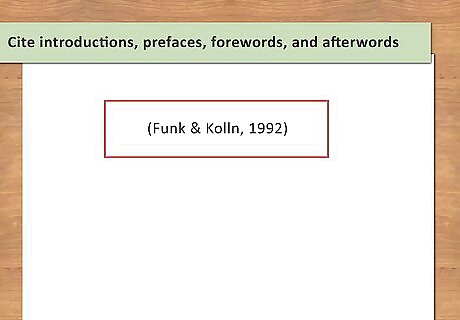
Cite introductions, prefaces, forewords, and afterwords. Treat in-text citations for introductions, prefaces, forewords, and afterwords like you would a simple author-date citation. Your citation would look like this, (Smith & Jones, 2005).

Include name and date when you cite personal information. Personal communication includes information gathered from interviews, e-mails, letters, and any other type of person-to-person communication. To reference any of these sources, include the communicator’s name, the date of communication, and identify this source as “personal communication.” In-text citation: Smith stated that he conducted the experiment with the help of colleagues (personal communication, December 2, 2005). Parenthetical citation: “(Smith, personal communication, December 2, 2005).”
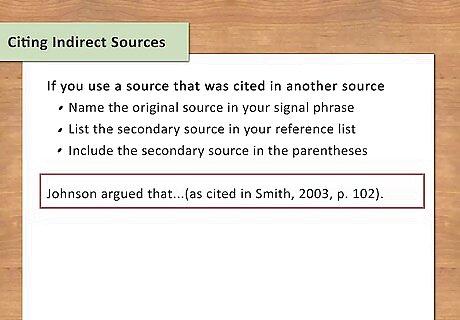
Use “qtd” to indicate an indirect source in a citation. Indirect sources are also called “secondary sources”; these are sources that are already cited by another source. The information from an indirect source is not the original source from which the information was initially collected. To cite this kind of source, use the original source in your single phrase and use the secondary source in parenthesis. Your citation would look like this: Smith proved within his experiment that….(as cited in Jones, 2006, p. 30).
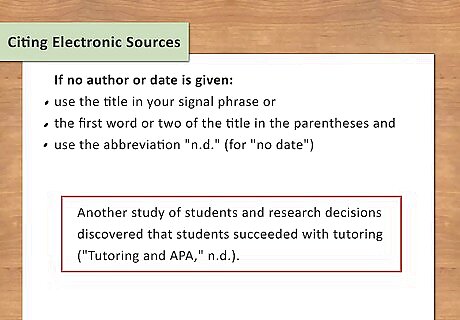
Cite electronic sources like any other kind of source, using the author-date approach to referencing. Your citation should look like this, Smith (2006) stated… If you come across an electronic source with no author or date provided, use the entire title or the first word or two of the title, plus “n.d.” to denote “no date”. For electronic sources without page numbers, try to incorporate as much information as possible that would help the reader find the text being referenced.


















Comments
0 comment